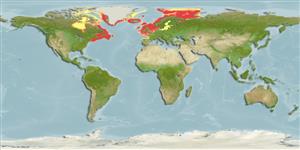Environment: milieu / climate zone / depth range / distribution range
Ecologia
marinhas; estuarina demersal; intervalo de profundidade 0 - 451 m (Ref. 58496). Polar; 80°N - 40°N, 95°W - 60°E
Eastern Atlantic: south-eastern coasts of Greenland, Jan Mayen Island, Iceland to British Isles and southward to Bay of Biscay, also North Sea, Baltic Sea, Spitsbergen and southern part of Barents Sea (including White Sea). Western Atlantic: James Bay in Canada to New York, USA (Ref. 7251). Arctic Ocean.
Comprimento de primeira maturação / Tamanho / Peso / Idade
Maturity: Lm 17.8, range 15 - 30 cm
Max length : 60.0 cm TL macho/indeterminado; (Ref. 9925); common length : 24.0 cm SL macho/indeterminado; (Ref. 4698); idade máx. registrada: 18 anos (Ref. 122394)
Espinhos dorsais (total) : 7 - 11; Raios dorsais (total) : 13 - 19; Espinhos anais: 0; Raios anais : 9 - 15; Vértebras: 34 - 39. Caudal fin rounded. Greenish brown above, often with dark blotches and bright milky-white spots above pectoral fins; underside cherry red (males) or light orange (females) with white spots; fins with dark bands (Ref. 4698).
Found on rocky bottoms with sand or mud, or among seaweeds (Ref. 4698). Benthic (Ref. 58426). Feeds on fishes, large crustaceans, occasionally polychaetes and amphipods (Ref. 4698). During the spawning season, the male's underside becomes deep red with white spots.
Eggs are deposited in a clutch on the bottom and defended by the male. Larvae hatch after about 5 weeks.
Fedorov, V.V., 1986. Cottidae. p. 1243-1260. In P.J.P. Whitehead, M.-L. Bauchot, J.-C. Hureau, J. Nielsen and E. Tortonese (eds.) Fishes of the North-eastern Atlantic and the Mediterranean. UNESCO, Paris. Vol. 3. (Ref. 4698)
Status na Lista Vermelha da UICN (Ref. 130435: Version 2024-2)
Ameaça para os humanos
Harmless
Uso pelos humanos
Pescarias: espécies comerciais; Aquário: Aquários públicos
Ferramentas
Relatórios especiais
Baixar XML
Fontes da internet
Estimates based on models
Preferred temperature (Ref.
123201): 0.4 - 10.3, mean 4.5 °C (based on 1225 cells).
Índice de diversidade filogenética (Ref.
82804): PD
50 = 0.5000 [Uniqueness, from 0.5 = low to 2.0 = high].
Bayesian length-weight: a=0.00871 (0.00718 - 0.01057), b=3.15 (3.09 - 3.21), in cm total length, based on LWR estimates for this species (Ref.
93245).
Nível Trófico (Ref.
69278): 3.9 ±0.0 se; based on diet studies.
Generation time: 3.1 ( na - na) years. Estimated as median ln(3)/K based on 1
growth studies.
Resiliência (Ref.
120179): médio(a), tempo mínimo de duplicação da população 1,4 - 4,4 anos (tm=2; Fec=2,742).
Fishing Vulnerability (Ref.
59153): Low to moderate vulnerability (34 of 100).
Nutrients (Ref.
124155): Calcium = 85.8 [16.9, 288.9] mg/100g; Iron = 0.442 [0.184, 1.318] mg/100g; Protein = 18.9 [16.1, 21.1] %; Omega3 = 0.635 [0.263, 1.864] g/100g; Selenium = 21 [8, 53] μg/100g; VitaminA = 5.56 [1.06, 28.97] μg/100g; Zinc = 0.655 [0.268, 1.159] mg/100g (wet weight); based on
nutrient studies.
